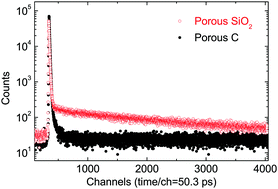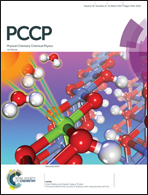Effects of electrical conductivity on the formation and annihilation of positronium in porous materials†
Abstract
In this paper we show the preliminary evidence that the formation of positronium depends on the electrical conductivity of porous materials. Porous nano γ-Al2O3 was chosen as the base material, and it was filled with carbon of different allotropes (commercial graphite, carbon black, carbon nanotubes and home-made ordered mesoporous carbon) by a mechanical mixing method. The positron lifetime and Doppler broadening of the annihilation radiation were measured for these composites. In the pure γ-Al2O3 sample, there are two long positron lifetime components τ3 (3.5 ns) and τ4 (101.3 ns) with intensities of 1.0% and 24.6%, which indicates the formation and annihilation of positronium in small and large pores, respectively. In the carbon filled γ-Al2O3 samples, the longest lifetime τ4 and its intensity I4 both show a continuous decrease with increasing carbon content. The Doppler broadening S parameter shows a similar tendency to τ4 and I4. This suggests that carbon has a quenching effect on positronium and also inhibits the formation of positronium. Among these four carbon allotropes, carbon nanotubes have the strongest quenching and inhibition effect, while graphite has the weakest effect. A detailed study further reveals that the decreasing rate of τ4 and I4 as well as the S parameter depend on the electrical conductivity of the carbon filled γ-Al2O3 and also the specific surface area of the filled carbon. Our results suggest that the formation and annihilation of positronium are strongly affected by the electrical conductivity of the materials.



 Please wait while we load your content...
Please wait while we load your content...